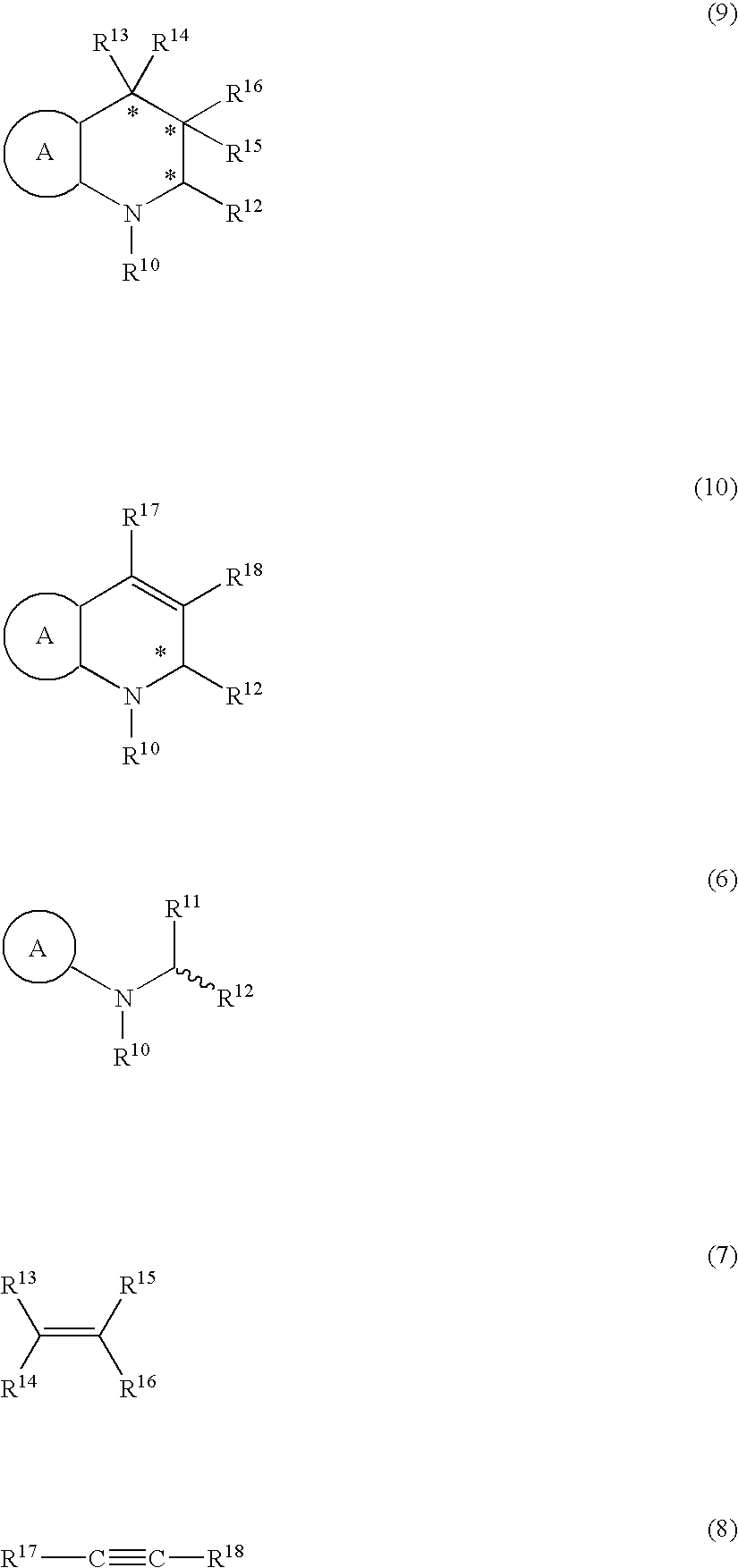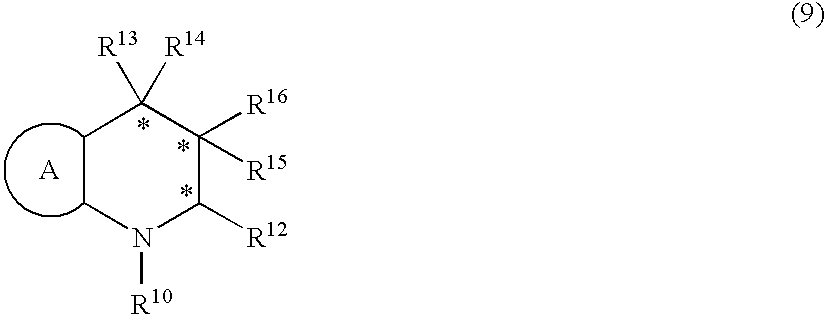Method for producing optically active amines
- Summary
- Abstract
- Description
- Claims
- Application Information
AI Technical Summary
Benefits of technology
Problems solved by technology
Method used
Image
Examples
reference example 1
[0218] Preparation of chiral Lewis acid represented by the following formula:
[0219] Under nitrogen atmosphere, a mixture of (R)-binaphthol 50 mg (0.17 mmol), 1M-trimethoxyboran-dichloromethane 0.09 mL (0.09 mmol) and dichloromethane 10 mL was refluxed for 3 hours with a cooling tube loaded with molecular sieve 4A 4 g to give a dichloromethane solution (0.09 mmol) of chiral Lewis acid represented by the formula mentioned above. The solution was then concentrated under reduced pressure to a total volume of 5.0 ml to give 0.018M (chiral Lewis acid)-dichloromethane solution.
example 1
Synthesis of methyl (2R,4S)-(2-ethyl-6-trifluoromethyl-1,2,3,4-tetrahydroquinolin-4-yl)-carbamate
[0220] 4-Trifluoromethylaniline 161.3 mg (1.0 mml) and propionaldehyde 58.1 mg (1.0 mmol) in dichloromethane 5.0 mL were mixed and stirred at ambient temperature for 3 hours. Then, the solution of N-propylidene-4-trifluoromethylphenylamine in dichloromethane 2.5 mL obtained above, methyl N-vinylcarbamate 111.0 mg (1.1 mmol) and the solution 2.5 mL (0.045 mmol) of 0.018 M (chiral Lewis acid)-dichloromethane prepared in Reference Example 1 were mixed and stirred at −30° C. for 5 hours. Upon completion of the reaction, 2.5 wt % aqueous sodium bicarbonate 2.0 mL was added to the reaction mixture and the mixture was stirred for 10 minutes. The organic layer was washed with water 3.0 mL and dried over anhydrous magnesium sulfate. After removal of the solvent by evaporation in vacuo, the residue was purified by silica gel column chromatography (n-hexane:ethyl acetate=3:1) to give the title com...
example 2
Synthesis of methyl (2R,4S)-(2-ethyl-6-trifluoromethyl-1,2,3,4-tetrahydro quinolin-4-yl)-carbamate
(1) Synthesis of (1-benzotriazole-1-ylpropyl)-(4-trifluoromethylphenyl)amine
[0224] Under nitrogen atmosphere, 4-trifluoromethylaniline 30.0 g (186.0 mmol) and propionaldehyde 11.88 g (204.6 mmol) were added successively to a mixture of benzotriazole 22.16 g (186.0 mmol) and toluene 90 mL at ambient temperature, and the mixture was stirred at ambient temperature for 18 hours. Upon completion of the reaction, n-heptane 100 ml was added to the reaction mixture. Then, the mixture was cooled gradually to −10° C, and stirred for 3 hours. The precipitated crystals were filtered to give the desired (1-benzotriazol-1-ylpropyl)-(4-trifluoromethylphenyl)amine 54.0 g in 90.6% yield.
[0225]1H-NMR (200 MHz, CDCl3):0.97 (t, 3H, J=7, 4 Hz), 2.37 (m, 2H), 5.04 (brd, 1H, J=7.8), 6.31 (m, 1H), 6.74 (d, 2H, J=8.4 Hz), 7.30-7.46 (m, 4H), 7.69 (d, 1H, J=8.0 Hz), 8.09 (d, 1H, J=8.4 Hz)
(2) Synthesis of meth...
PUM
| Property | Measurement | Unit |
|---|---|---|
| Current | aaaaa | aaaaa |
| Optical activity | aaaaa | aaaaa |
Abstract
Description
Claims
Application Information
 Login to View More
Login to View More - R&D
- Intellectual Property
- Life Sciences
- Materials
- Tech Scout
- Unparalleled Data Quality
- Higher Quality Content
- 60% Fewer Hallucinations
Browse by: Latest US Patents, China's latest patents, Technical Efficacy Thesaurus, Application Domain, Technology Topic, Popular Technical Reports.
© 2025 PatSnap. All rights reserved.Legal|Privacy policy|Modern Slavery Act Transparency Statement|Sitemap|About US| Contact US: help@patsnap.com



